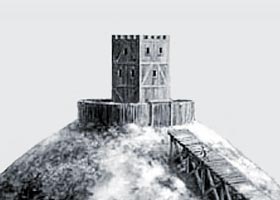 |
Life in a Motte and Bailey Castle |
| Life in a Motte and Bailey Castle Life in a Motte and Bailey Castle - the Inhabitants | |||
| The Lord of the Castle and possibly his family would live in the most protected part of the castle - the Tower or the Keep. Servants would be expected to provide food for the Nobles and soldiers. The Soldiers were well paid and lived within the Bailey of the castle. Other occupations within the Motte and Bailey castle were the Blacksmiths - to keep a supply of arrowheads, the Stable hands to help with the horses and the kitchen staff. Like the Feudal system itself, life in a Motte and Bailey castle was a pyramid shape with the Lord at the top of the pyramid - literally living the high life! And the quality of life decreasing according to the position of the inhabitant! |
Life in a Motte and Bailey CastleLife in a Motte and Bailey Castle
Life in a Motte and Bailey Castle - the Occupants of the Bailey Life in a Motte and Bailey Castle - the Soldiers Life in a Motte and Bailey Castle - the workers in the Bailey
|
Life in a Motte and Bailey Castle - the Tower
If the Tower had a Great Hall then there would be some forms of entertainment - the richer the Lord the better and more varied the entertainment. Meals would be also be taken in the great Hall and religious observances such as Mass would be taken here. Life in the Tower would also be noisy, dirty, busy and smoky - there was little privacy for any of the inhabitants. Life in a Motte and Bailey Castle - the Lord and his Family
Life in a Motte and Bailey Castle - the Feudal System
Life in a Motte and Bailey Castle |
| © March 2018 SiteSeen Ltd. | Cookies Policy | Privacy Statement | By Linda Alchin | ||
